This article was republished with permission from WTOP’s news partners at Maryland Matters. Sign up for Maryland Matters’ free email subscription today.
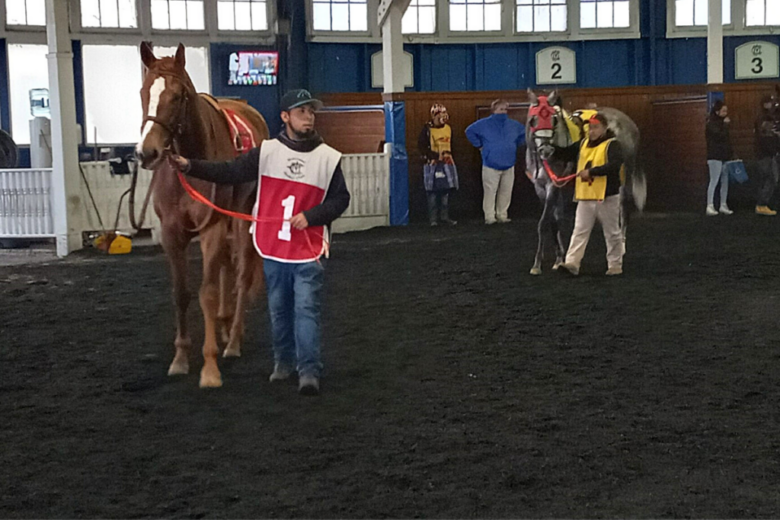
This content was republished with permission from WTOP’s news partners at Maryland Matters. Sign up for Maryland Matters’ free email subscription today.
On a recent gloomy Saturday, Kevin O’Keeffe, an Annapolis lobbyist, was pacing on the patio overlooking Laurel Park Race Track like an expectant father.
A quarter a mile around the racetrack oval, Away to Return, a filly O’Keeffe owns with six partners, was entering into the starting gate, barely visible from where O’Keeffe was standing. This was Away to Return’s third race of Laurel Park’s winter season — she finished fifth in the first and won the second — but the experience hasn’t become any easier for O’Keeffe and his compatriots.
“If I turn my back [to the track], it’s because I’m nervous,” said O’Keeffe’s wife, Mary Frances.
Until that Saturday, I’d been to Laurel Park exactly once, about two decades ago, to cover a fundraiser for the late state Senate President Thomas V. Mike Miller Jr. (D), a devoted friend of the Maryland Jockey Club, which owns the track. Then-U.S. Senate Majority Leader Tom Daschle (D-S.D.) was the featured attraction, and as I recall, he stood in line with everybody else to get his own beer, rather than relying on a staffer to fetch it. That seemed noteworthy at the time.
But here I was again, older if not wiser, at O’Keeffe’s invitation, to see his horse run and maybe learn a thing or two about the Maryland racing scene. I know the horse breeding and horse racing industries in Maryland are important, with a long and storied history. I’ve seen their lobbying firepower in Annapolis. Yet even after hosting a dozen or so Kentucky Derby parties through the years — a great excuse to drink mint juleps, eat a lot, and watch “the most exciting two minutes in sports” — what I actually know about horse racing basically comes from the Marx Brothers’ “A Day at the Races,” an early Stanley Kubrick film called “The Killing” (worth checking out), and the works of Damon Runyon.
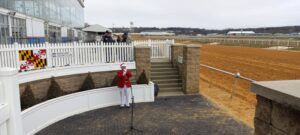
There are 8 million stories in the naked city and, no doubt, innumerable fascinating untold stories from Maryland thoroughbred race horse owners, breeders and trainers. But until I heard from O’Keeffe, whom I’ve known for at least 20 years, I wasn’t inclined to pursue them.
Of course, I was also intrigued by O’Keeffe’s roster of partners who own the horse along with him, including former state Sen. Edward Kasemeyer (D), lobbyist Sushant Sidh, and Stephen M. Ports, a health care policy consultant and Mike Miller’s former chief of staff.
They’ve formed a partnership called Old Line Racing, and bought Away to Return, a 3-year-old, earlier this year for the bargain-basement price of $40,000. She’s a beautiful horse, red chestnut, with a white blaze down her nose.
As a yearling, the filly fetched $350,000. Her sire was a horse named Ghostzapper, who won a high-stakes Breeders’ Cup race in 2004. And through her dam, she’s a granddaughter of a horse called Big Brown, who won the Kentucky Derby and the Preakness Stakes in 2008. But she wasn’t flourishing earlier in her career, so she was available for a reduced price following a claiming race earlier this year.
O’Keeffe, a lifelong racing fan, was the impetus for the purchase. As he got older, he found himself following the sport more and more closely.
“I went from collecting baseball cards to following politics to, now, horse racing,” he said.
O’Keeffe, 57, has spent a lifetime working in Maryland politics, including a decade-long stint as director of state relations for the City of Baltimore — his hometown — when Kurt L. Schmoke (D) was mayor. He then held a similar position in Anne Arundel County, ran unsuccessfully for Congress in 2006, and has spent many years as a contract lobbyist in Annapolis. He is also connected to Annapolis insiders by marriage — Mary Frances O’Keeffe’s older sisters are Del. Geraldine Valentino-Smith (D-Prince George’s) and Ellen Valentino, another State House lobbyist. Both were on hand at Laurel Park with members of their family.
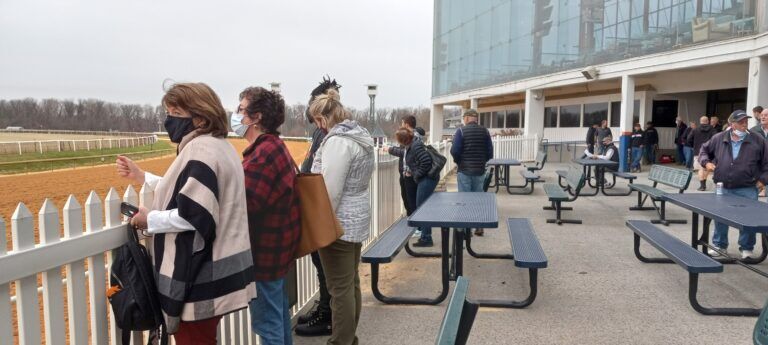
In recent years, O’Keeffe’s interest in horse racing has turned into full-blown passion. Now he’s a board member of the Kentucky Equine Education Project Foundation, the charitable arm for the industry association. He’s also involved with projects for Saratoga Race Course in upstate New York.
In the State House, O’Keeffe was always one of those guys who seemed to know everything that was going on — quick with a tip, or an analysis of a political situation, or suggestions for avenues of inquiry for a reporter to check out. Politics and the law are still his vocation, but horse racing is his avocation.
“I only tweet about racing now,” O’Keeffe said.
Yet it wasn’t until a college friend asked O’Keeffe whether he could help her buy a horse for her husband that he thought about becoming a horse owner himself. Now, he has become even more steeped in that world, familiar and friendly with handicappers, racetrack announcers, trainers and jockeys. It’s very much an island onto itself. Just recently, an 81-year-old friend from Kentucky called O’Keeffe with a tip on a horse in an upcoming race at Laurel Park.
“I’ve learned a lot,” he said. “I’ve met a lot of nice, interesting people from all over.”
‘Moving up in class’
From the road, Laurel Park is a hulking behemoth. It looks a little like a dowdy cruise ship. Even racing enthusiasts would agree that it appears to be past well past its prime. O’Keeffe warned me that the crowd on the day my wife and I were coming would probably be sparse.
Years ago I tagged along with a legislative committee when lawmakers visited Rosecroft Raceway in Fort Washington on a desultory summer day. Now that was a depressing experience. Bettors were crammed into a few rooms with cinderblock walls illuminated by yellow florescent lights, staring intently at TV screens. Cigarette smoke hung heavy in the air. The AC may have been on, but everybody was sweating. And if there was live racing taking place outside, I don’t remember it — no one was paying attention.
But the interior of Laurel Park was gussied up in its holiday finery and looked pretty festive. The crowd was bigger than I expected. Visitors to the clubhouse are greeted, incongruously, with statues of Asian warriors. But everything else inside screams horses, drinking and betting.
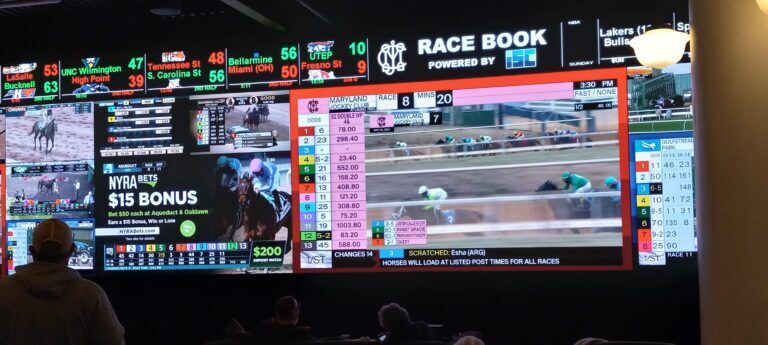
Most of the interior is dedicated to bars and restaurants and wagering stations. And TV screens are everywhere — most showing races from other tracks around the country. Wagers can be placed on all these races, and for most of the day it’s impossible to go even a minute without seeing some racing action somewhere on the TVs. With sports betting ramping up, the TV screens also are showing sporting events from across the country, including hoops games of colleges you’ve never heard of.
There’s a huge grandstand enclosed by glass, but on the Saturday we were there, there were no more than a dozen people in seats, watching action on the track. Outside, the crowd wasn’t much bigger. A few paid attention when a bugler, clad in a red hunting jacket, blew “First Call” before each race. And a knot of spectators gathered outside the paddock, where the horses and their jockeys limber up before each race.
Even if you know very little about the Maryland racing scene, you’ve probably read that it has a caste and class system. Stable hands often often live in substandard conditions, right on the race track grounds — even though racing is known as the sport of kings.
Most bettors and revelers at Laurel Park on the Saturday we visited were middle-aged white guys, some flouting mask mandates. On hand that day — not part of the Old Line entourage — were former delegate and retired judge Richard A. Palumbo and Maryland Housing and Community Development Secretary Kenneth C. Holt, co-owners of a horse stable. Holt may have been the best-dressed man at the track, with a blue blazer and fancy scarf.
Most folks handling the animals are people of color.
Laurel Park had to cancel eight days of its calendar in early December due to a new dirt track that turned out to be unusually rough. Eight horses suffered leg fractures so severe this fall that they had to be put down. It was the third day since racing had resumed when I visited, and thankfully, the horses all seemed to be running well and without incident. Still, the presence of ambulances on the track is jarring for a newcomer.
Away to Return was running in the sixth race that day, a competition among previous winners of Laurel Park races this year, and early handicappers gave her 10-1 odds — putting her in the middle of the pack in the nine-horse field. But as the race drew closer, while the horses were walking through the circular paddock, a frenzy of late betting brought her odds all the way up to 2-1 at some point, briefly making her the favorite.
“I don’t know what’s happening,” Kasemeyer said as he was standing by the paddock with his wife, State House lobbyist Pamela Metz Kasemeyer, and their two children.
“Kasemeyer bet too much,” O’Keefe groused.
The odds on the race shifted wildly for a few minutes, but by post time, Away to Return was at 12-1. The horse had been assigned the No. 1 post position at the gate.
“First in your program and first in your heart,” O’Keeffe said.
But the No. 1 position is unenviable for most horses. It places them along the inside rail and makes it harder to break away from the crowd. Still, Away to Return broke out of the gate quickly, and led for about half of the six-furlong race.
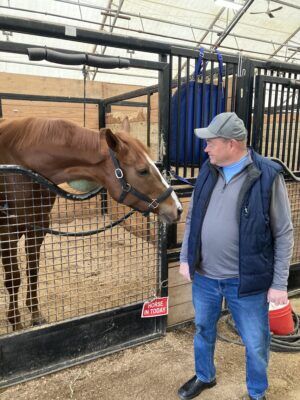
But the results seemed preordained: The heavy favorite, Fraudulent Charge, stormed ahead.
“Fraudulent Charge is not going to be beaten,” track announcer Dave Rodman said.
Three horses raced toward the finish line nearly tied for second, but when it was over, Away to Return finished fourth, just a nose behind her competitors. The horse’s owners were naturally disappointed, but also satisfied, because the finish meant she could continue to compete against other Laurel Park winners going forward.
“Moving up in class,” Kasemeyer said.
Away to Return’s owners plan to keep racing her at Laurel Park throughout the winter season. If she’s healthy and competitive enough, they’d like to bring her to Pimlico Race Course in Baltimore for Maryland’s abbreviated spring racing season. After that, they’ll see. Most race horses compete until they are 4 or 5 years old, though some geldings can go until they are 7 or 8, O’Keeffe said.
Gambling is everywhere these days, and the decline of the horse racing industry has been painfully slow. Back in the 1950’s, it was among the top three most popular American sports, along with baseball and boxing. But those days are long gone.
O’Keeffe evangelizes about a day at the track for anyone who will listen.
“There’s so much gambling now, but at least when you go to the track, you see beautiful animals,” he said. “Live action. It’s outdoors. It’s much better than being in a windowless room in a casino.”
My wife and I thoroughly enjoyed ourselves — and we didn’t spend a dime. But we were very mindful of the industry’s dangers, its shortcomings, scandals and inequities. I’ve also been flashing on a line from that Kubrick movie I mentioned, “The Killing”: “Anytime you take a chance, you better be sure the rewards are worth the risk.”







